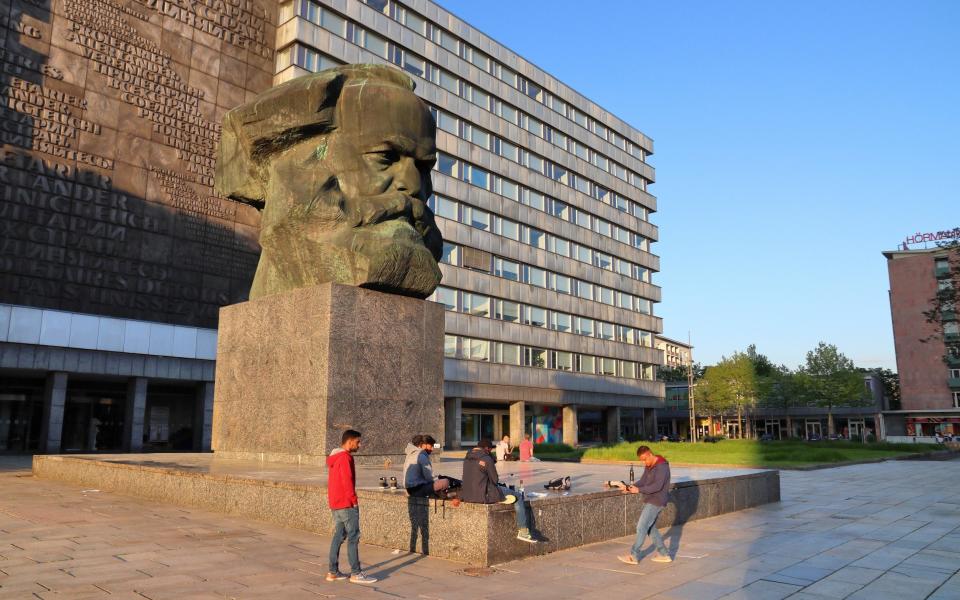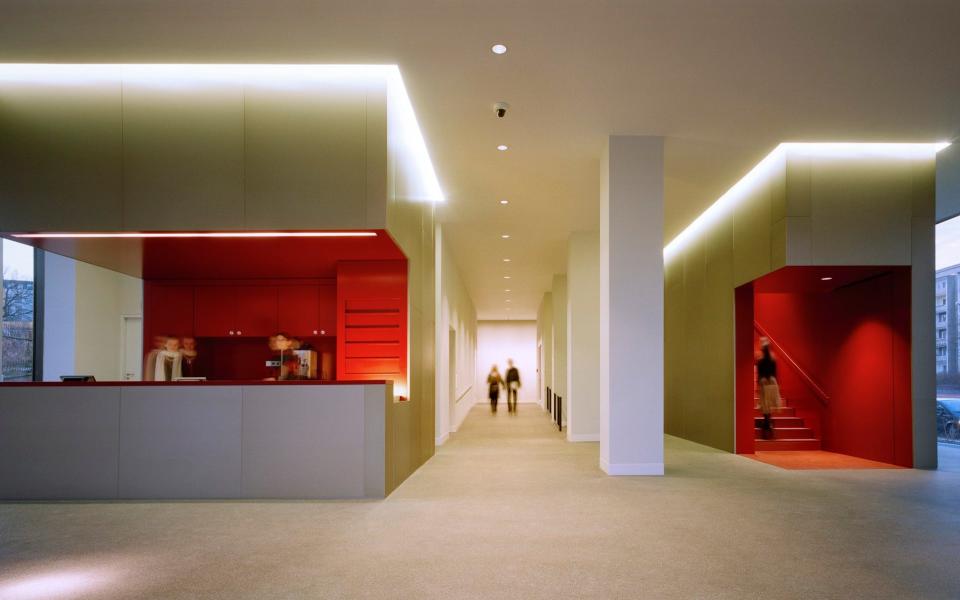Sitting in the penthouse bar of the Congress Hotel in Chemnitz, looking at the bleak modern cityscape below, you get a good idea of what Western Europe would have looked like if Russia had won the Cold War.
Below this ugly socialist skyscraper are rows and rows of brutalist apartment buildings – soulless, faceless, monotonous – and in the center of this concrete maze, glowing like a grumpy prophet, stands a gigantic bust of the man who gave his name to this communist dystopia , Karl Marx. “Workers of the world unite!” reads the proclamation on the wall behind him.
What happened to Karl-Marx-Stadt? As a schoolboy in the 1980s, staring at maps of Eastern Europe and wondering if I would ever get the chance to travel there, East Germany’s Karl Marx City seemed particularly strange. What had it done to earn that creepy title? Did you have to be a Marxist to live there? If you went there and you weren’t a Marxist, would they ever release you? Even as a child, I sensed that there was something sinister about imposing one person’s name on an entire city. And then the Berlin Wall fell and Karl-Marx-Stadt disappeared.
Of course, the actual city did not disappear. It only returned to its old name, Chemnitz. But for anyone outside Germany, it might as well have disappeared. After Germany was reunified in 1990, Western tourists flooded into East Germany, but they steered a wide berth toward Chemnitz, and no wonder. In any case, there wasn’t much left to see.
Next year, however, the city formerly known as Karl-Marx-Stadt will be crowned European Capital of Culture. I have to admit, when I first heard the news, it sounded like a particularly unfunny German joke. Has this forgotten city enjoyed an unlikely renaissance? I came here to find out.
I first came to Chemnitz in 2010, twenty years after German reunification. I had traveled all over East Germany and was impressed by the rapid pace of change, but here in Chemnitz it felt like the Berlin Wall had only been standing for a few months. “All power to the Five-Year Plan!” read a faded slogan on an abandoned factory wall. It wasn’t just Marx’s colossal failure, or the proletarian housing projects surrounding it. Above all, it was the atmosphere of listless indolence. The city center seemed deserted. Where had everyone gone?

In 1900 Chemnitz was one of the richest cities in Germany, an industrial boom town, the engine room of the Second Reich. It was not only famous for its factories. It was also known for its art and music. Remarkably, the city emerged relatively unscathed from the Second World War until March 5, 1945, when the beautiful, historic Altstadt (Old Town) was razed to the ground by the RAF.


When Germany surrendered, most of Chemnitz was in ruins, but other German cities were even more severely damaged and have since made a remarkable recovery. The reason so little of Chemnitz survived was because the new communist rulers decided to create a brand new city amid the rubble, a futuristic citadel of faceless tower blocks. In 1953 this new city was renamed Karl-Marx-Stadt. Chemnitz no longer existed.
Ironically, Marx never even set foot in Chemnitz (he was born and raised in Trier, in western Germany, 560 kilometers away). The reason it was renamed that way was because the communists wanted to turn it into a proletarian utopia, a workers’ paradise built in a grim new Soviet style.
After reunification, the residents of Karl-Marx-Stadt voted three to one to restore the city’s old name. For anyone oppressed by the old regime, this was an important symbolic change – among the communists, even referring to your hometown as Chemnitz was a black mark on your name – but the practical benefits took much longer to sink in. .
More than any other East German city, Chemnitz embodied the painful transition from communism to capitalism. If you were young, this was a fantastic opportunity. When you were middle-aged, you often became redundant and left behind. Old, rusty industries collapsed, and the new high-tech industries that replaced them required far fewer workers. The population shrank as young people moved west in search of work. Germany’s new far-right party, Alternative für Deutschland, received significant support.
When I return here after 14 years, it is clear that Chemnitz has improved a lot. Smart new buildings are rising, shabby old buildings are improved. There are more people in the shops and on the streets. Unlike my last visit, in 2010, it feels like you can build a future somewhere.
But it’s still a million miles away from what most Brits would consider a conventional holiday destination – and probably always will be. Even for a weekend city trip it is quite a challenge. If you like modern art or modernist architecture, there are several sights scattered around the city, but fewer than in Leipzig, an hour’s drive away.
If you’re curious about what went on behind the Iron Curtain, a stroll through the city center is an intriguing cautionary tale. This is what happens when city planners wipe away centuries of history and impose a new ideology on a defeated, powerless population. For students of history or sociology, it’s fascinating, but even if you’re mainly interested in East Germany, there are several other cities you should see before coming here (such as Dresden, Leipzig, Weimar and Potsdam).
Why does this inconspicuous city become the European Capital of Culture? Because this EU program is about boosting struggling regions and agglomerations, rather than highlighting cultural hotspots that are already on the map.


Sometimes this initiative can change the reputation of a distressed city. It worked for Glasgow and Liverpool, but these are two great metropolises, for all their problems. Chemnitz is more like Coventry or Croydon.
After all it’s been through, I hope its year as the Capital of Culture will boost Chemnitz, but future visitors should know that this place is still a work in progress and not a finished product. If you want to see what became of Karl-Marx-Stadt, a short visit is well worth it, but I recommend staying in Dresden or Leipzig and doing it as a day trip.
On the green edge of the city, where few bombs fell, there is still something of old Chemnitz: large old villas with leafy gardens, remnants of a conquered era. It is poignant and rather eerie to wander along these graceful avenues, thinking what a pleasant, prosperous place this was, before the catastrophes of Nazism and Communism, the Holocaust, the two world wars…
Will Chemnitz ever be beautiful again? I doubt it. Too much has been lost, and much of what has replaced it is bland and anodyne. Yet among the people I met here, I found a sense of local pride and discreet optimism that is often missing in more touristy destinations. The last time I came here, the specter of Marx loomed large over Chemnitz. Now he seems like a harmless curiosity, the strange souvenir of a ruthless philosophy that condemned a generation to serfdom.
Chemnitz has weathered the worst of times, a century full of disasters, and has come out smiling, and that is inspiring in its own small way.
Chemnitz essentials
Unless you’re a big fan of Cold War history, the best way to visit Chemnitz is on a day trip from Dresden or Leipzig, just an hour away on the Deutsche Bahn. If you want to stay overnight, the Chemnitzer Hof is the smartest hotel, a comfortable and attractive four-star hotel that hosted VIPs from the Eastern Bloc during the communist era. Doubles from around £100 per night, without breakfast.
Eating out in Chemnitz is generally affordable and of good quality, but I haven’t found anything I would particularly recommend. There are plenty of good chains. My favorite is Nordsee, a cheap and cheerful seafood restaurant that serves tasty takeaway and sit-down meals.
Remarkably, for a relatively small city, Chemnitz has a wide range of excellent museums. Kunstsammlungen Chemnitz consists of five art galleries, in various scenic locations around the city. Kunstsammlungen am Theaterplatz is the most important, with an excellent range of German Expressionists. The Gunzenhauser Museum has a smaller collection, but the photos are just as good. Villa Esche is a stylish modernist mansion built and furnished by the great Belgian architect and designer Henry van de Velde. The Schlossberg Museum houses a modest collection of local history, but the best exhibit is the building: a medieval monastery on a wooded hill, overlooking a tranquil lake. The Saxon Industrial Museum, in an old factory, oversees Chemnitz’s heyday as an industrial metropolis. The most spectacular exhibition is SMAC, Saxony’s state archeology museum, housed in a striking Art Deco department store, Schocken, which was founded by a German Jewish family and then seized by the Nazis.


I flew to Berlin with British Airways (which flies from Heathrow and London City) and traveled on to Chemnitz by train: two hours from Berlin Brandenburg Airport to Leipzig, then another hour to Chemnitz. Ryanair flies from Stansted to Leipzig and from Birmingham, East Midlands, Manchester and Stansted to Berlin. EasyJet flies to Berlin from Luton, Bristol and Edinburgh.
For more information, visit chemnitz.travel or germany.travel.